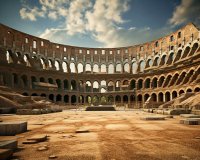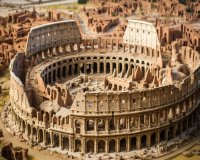Rome Revealed: Navigating the Colosseum/s Arena and the Forum

Rome Revealed: Navigating the Colosseum's Arena and the Forum in Rome
Rome, the Eternal City, is a treasure trove of history, culture, and ancient wonders. Among the many iconic landmarks in this city, the Colosseum and the Roman Forum stand as testaments to the grandeur of the Roman Empire. In this article, we'll delve into the heart of Rome and explore the fascinating history of these two remarkable sites.
The Colosseum: An Architectural Marvel
The Colosseum, also known as the Flavian Amphitheatre, is one of Rome's most famous landmarks. It was built in 70-80 AD and could hold up to 80,000 spectators. This massive amphitheater was the stage for gladiatorial combat, mock sea battles, and various public spectacles.
Its iconic elliptical design, with towering arches and tiers, still astounds visitors today. As you step inside, you'll find yourself walking through the labyrinthine passageways and ascending the tiers, giving you a sense of what it was like to be part of the Roman crowd eagerly anticipating the events in the arena.
The arena floor itself, the centerpiece of the Colosseum, is a remarkable feat of engineering. It has been partially reconstructed to reveal the intricate underground chambers where gladiators and animals were held before their performances. Walking on the same sands where history was made is a spine-tingling experience.
The Roman Forum: A Center of Ancient Life
Adjacent to the Colosseum lies the Roman Forum, a sprawling archaeological site that was once the political, social, and economic center of ancient Rome. As you explore the Forum, you'll be stepping into the heart of the Roman Republic and the early days of the Empire.
The Forum is a captivating place where you can see the ruins of temples, basilicas, and government buildings. The Temple of Saturn, the Arch of Septimius Severus, and the Curia are just a few of the many incredible structures that can be found here.
Walking along the ancient stone paths, you can imagine the great orators of Rome, like Cicero, delivering speeches in the Forum. The Via Sacra, the sacred road, stretches through this area and was the route of many Roman triumphal processions.
Navigating These Historic Sites
When visiting the Colosseum and the Roman Forum, it's important to plan your trip carefully. Here are some tips to make the most of your experience:
- Buy Tickets in Advance: The Colosseum and the Forum can get crowded, so it's wise to purchase your tickets online ahead of time to avoid long lines.
- Guided Tours: Consider taking a guided tour to gain deeper insights into the history and significance of these sites.
- Wear Comfortable Shoes: Both sites involve a lot of walking, so comfortable footwear is essential.
- Respect the Heritage: These are ancient and fragile sites, so be sure to follow all rules and regulations to help preserve them for future generations.
In conclusion, Rome's Colosseum and the Roman Forum are not just remnants of a bygone era; they are living testimonies to the grandeur and achievements of the Roman civilization. Exploring these sites is like stepping back in time and getting a glimpse of the rich history that has shaped our modern world. Don't miss the opportunity to uncover the secrets of the Colosseum's arena and the grandeur of the Roman Forum when you visit the Eternal City.
Rome: Myths and Legends of the Roman Forum
Experience the compelling tales and rich history that resides within the heart of ancient Rome. Delve into the historic center of the Ancient Roman Empire as you embark on a guided tour of the Roman Forum.
Discover Rome's Heritage
With every step, you'll be enveloped in stories that date back centuries. From the epic founding of Rome by the legendary Romulus and Remus, to the near divine tales of Julius Caesar, immerse yourself in tales of valiant soldiers and shrewd politicians that once tread on the same grounds. The Roman Forum is not just a location; it's a testament to one of the most powerful empires that ever existed, filled with gods, myths, and legends that have shaped civilizations.
A Tour Designed for All
This exploration is crafted to captivate individuals from every walk of life. Children will find themselves enthralled by ancient narratives while adults unravel the intricate details that defined one of history's most influential societies. Guided by professional experts, your journey will not just be educational, but also unforgettable.
Meeting Point
To begin your historical escapade, head to L.go della Salara Vecchia, 00186 Roma. Keep an eye out for signs or flags bearing the name 'Kirba Tours' to locate your guide.
Join us, and relive the legendary tales that have withstood the test of time./
The Architecture and History of the Colosseum in Rome
The Colosseum, also known as the Flavian Amphitheatre, stands as an iconic symbol of ancient Roman engineering and entertainment. Located in the heart of Rome, this colossal structure has a rich history and architectural significance that has fascinated people for centuries.
Architectural Marvel
The Colosseum's architecture is a testament to the ingenuity and skill of ancient Roman builders. Construction of this grand amphitheater began in AD 70-72, under the emperor Vespasian, and it was completed in AD 80 by his son Titus. This elliptical amphitheater could hold an estimated 50,000 to 80,000 spectators, making it one of the largest ancient amphitheaters ever built.
The Colosseum was primarily constructed using concrete and sand, with travertine limestone for the outer facades. Its distinctive elliptical shape allowed for optimal viewing of the gladiatorial contests and other events that took place within its walls. The amphitheater was equipped with a complex system of tunnels and elevators that allowed for the transportation of animals, gladiators, and props to the arena floor, creating a spectacle that was truly unmatched.
Historical Significance
The Colosseum was primarily used for gladiatorial contests and public spectacles such as animal hunts, mock sea battles, and dramas based on classical mythology. These events were often funded by emperors to gain favor with the Roman people. The Colosseum's history is stained with bloodshed, as countless gladiators and wild animals met their demise in the arena. However, it also served as a gathering place for the Roman populace, a space where the rich and poor could come together to be entertained.
Over time, the Colosseum fell into disrepair and was heavily plundered for its valuable materials. Earthquakes and fires further damaged the structure. Despite its decline, the Colosseum remained an enduring symbol of ancient Rome's architectural prowess and cultural heritage.
Preservation and Tourism
Today, the Colosseum stands as a UNESCO World Heritage Site and is one of the most visited landmarks in the world. Efforts have been made to preserve and restore the amphitheater to its former glory, and visitors from all corners of the globe come to marvel at its grandeur and learn about its history.
The Colosseum offers a unique window into the ancient world, where visitors can walk through its corridors, stand on the arena floor, and imagine the roar of the crowd. The nearby Roman Forum and Palatine Hill complement the visit, providing a deeper understanding of ancient Rome's history and culture.
Conclusion
The Colosseum in Rome is not just a structure; it is a testament to the architectural and historical achievements of ancient Rome. Despite its violent past, it serves as a reminder of the grandeur and complexity of Roman civilization. Visiting the Colosseum is a journey through time, a chance to connect with the past and appreciate the enduring legacy of one of the world's most iconic monuments.
Rome: Skip the Line Colosseum, Forum, and Palatine Hill Tour
Discover the marvels of Rome's Colosseum, Forum, and Palatine Hill on this guided tour with skip-the-line access. Led by expert guides, delve into the rich history of these ancient landmarks.
Overview
Explore the iconic Colosseum with skip-the-line tickets, gaining priority access to the first and second levels. Marvel at the architectural brilliance and hear captivating stories about emperors, gladiators, and historic battles. See the Arch of Titus and the final resting place of Julius Caesar.
Continue your journey through Rome's Ancient City, delving into the Roman Forum. Pass landmarks like the Arch of Constantine, the House of the Vestal Virgins, and the burial site of Julius Caesar, all set on what was once a vast swampland. Ascend Palatine Hill, where the ruins of Imperial Palaces offer a glimpse into ancient Roman grandeur.
Details
Experience the Colosseum's wonder with expert guides and skip-the-line entry. Delve into the depths of history at the Roman Forum and Palatine Hill, immersing yourself in the stories of Rome's legendary past.
Highlights
- Expert guided tour of the Colosseum, Forum, and Palatine Hill
- Skip-the-line access to the Colosseum's first and second levels
- Explore the Roman Forum, home to ancient temples and monuments
- Visit Palatine Hill, the site of Imperial Palaces and stunning views of Rome
Meeting Point
The meeting point for the tour may vary based on the selected option. Please check your booking confirmation for details.
Important Information
- Participants must carry a valid government-issued ID/passport for entry
- Tours operate rain or shine, except in cases of site closure for safety reasons
- Security checks are mandatory at all entry points; no large bags or sharp objects allowed
- Meeting times are subject to change; participants will be notified in advance
Embark on a journey through ancient Rome's most iconic sites, led by knowledgeable guides who breathe life into history. Book your spot today for an unforgettable exploration of the Colosseum, Forum, and Palatine Hill.
The Secrets of the Roman Forum, Rome
The Roman Forum, nestled in the heart of Rome, is a treasure trove of history, art, and culture. This ancient site served as the center of Roman life for centuries, and beneath its well-trodden cobblestones, lies a wealth of secrets waiting to be uncovered.
Stretching over 130,000 square meters, the Roman Forum was the hub of Roman public life, bustling with political, religious, and social activities. Here, we delve into some of the fascinating secrets that make this site a captivating destination for history enthusiasts and tourists alike.
The Temple of Saturn
The Temple of Saturn, located at the western end of the Roman Forum, is one of the oldest structures on the site. Built in 497 BC, it housed the state treasury. The secret here lies in the inscription on the podium - "Senatus Populusque Romanus" (The Senate and People of Rome), which is often abbreviated as SPQR. This abbreviation can still be seen all over Rome, a testament to the enduring legacy of the Roman Republic.
The Rostra
The Rostra, a raised platform for public speeches, was where some of the most influential orators in Roman history, including Cicero and Julius Caesar, addressed the citizens. The secret here is that the word "rostra" itself is derived from the Latin word for "beak," a reference to the rostrums of ships that were used as decorations on the platform.
The Curia Julia
The Curia Julia was the meeting place of the Roman Senate. Its secrets include the intricately detailed marble floor, which was a magnificent example of Roman artistry. Beneath it, an older version of the Senate House, the Curia Hostilia, was discovered. This hidden layer of history shows the evolution of Roman governance over time.
The Lapis Niger
Just steps away from the Curia Julia lies the enigmatic Lapis Niger, a black stone monument covered in inscriptions. This is believed to be one of the oldest structures in the Roman Forum, and its secrets continue to baffle historians. Some believe it was a sacred site, while others see it as a memorial for a fallen leader. The truth behind its purpose remains shrouded in mystery.
The Umbilicus Urbis
The Umbilicus Urbis, or "Navel of the City," is a circular monument that was once the symbolic center of Rome. It marked the point from which all distances in the Roman Empire were measured. Its secret lies in the symbolism it held for the Romans, as it represented the heart and soul of their vast empire.
The House of the Vestal Virgins
The House of the Vestal Virgins was the residence of the priestesses responsible for maintaining the sacred flame of Vesta. The secret here is the importance of these women in Roman religious life. They were the keepers of the eternal flame, and their purity and dedication were highly revered by the Romans.
The Arch of Septimius Severus
This triumphal arch commemorates the victories of Emperor Septimius Severus and his sons. The secret here is the detailed relief sculptures that depict scenes from their military campaigns. These carvings offer a unique glimpse into the military prowess and propaganda of the time.
The Temple of Vesta
The Temple of Vesta, the goddess of the hearth, was one of the most sacred sites in the Roman Forum. Its circular shape is unique among Roman temples, and its secret is the enduring mystery surrounding the rituals and ceremonies performed here by the Vestal Virgins. What exactly transpired within its hallowed walls remains largely unknown.
These are just a few of the many secrets that the Roman Forum holds within its ancient stones. As you explore this remarkable archaeological site, you'll find that every corner reveals another layer of history, adding to the rich tapestry of Rome's past. It's a place where the echoes of Roman voices still resonate, and the secrets of a once-mighty empire continue to captivate and inspire.






